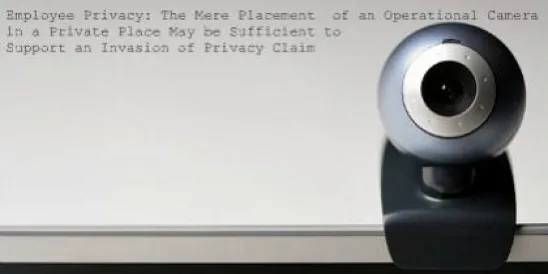Courts across the nation are divided on the question of whether a person is unlawfully intruding for purposes of an invasion of privacy claim by placing a camera in a private place without ever viewing or recording the victim. Courts in several states, including Illinois, have concluded that the installation of surveillance equipment in a private place is sufficient to support an invasion of privacy claim. That is, an intrusion occurs when the defendant performs an act that has the potential to impair a person's peace of mind and comfort associated with the expectation of privacy. On the other hand, courts in other states have adopted a standard of intrusion requiring that the defendant either see or hear the victim’s private activities. Courts in other states, including Wisconsin, have yet to address the issue. In a pivotal case with potential implications for those courts following the majority approach (including Illinois) or those that have yet to address the issue (including Wisconsin), the Iowa Supreme Court recently held that the mere placement of an operational camera in a private place is sufficient to support an invasion of privacy claim.
The Iowa standard for a claim of invasion of privacy is typical of many other states. In order to demonstrate a claim of invasion of privacy based on unreasonable intrusion under Iowa law, one must show (1) the intentional intrusion into a matter the person has a right to expect privacy, and (2) the act to be highly offensive to a reasonable person. On December 23, 2011, the Iowa Supreme Court discussed what qualifies as "an intrusion" under Iowa’s invasion of privacy tort when it decided Koeppel v. Speirs and Miller v. Speirs, a pair of cases filed against an employer who attempted to videotape his assistants’ activities in the bathroom. In ruling for the employees, the Iowa Supreme Court held that an electronic invasion occurs under the “intrusion on solitude or seclusion” component of the tort of invasion of privacy when the plaintiff establishes by a preponderance of the evidence that the electronic device or equipment used by a defendant could have invaded privacy in some way.
Robert Speirs was an insurance agent who employed two employees, Sara Koeppel and Deanna Miller, to assistant him in his business. In October 2005, Speirs noticed Miller’s work began to deteriorate. In response, Speirs decided to monitor Miller’s activities using a hidden camera, which he originally placed in the reception area. After allegedly finding a hypodermic needle near Miller’s car in the office parking lot, Speirs moved the camera to the office’s unisex bathroom. After unsuccessfully working with the equipment to produce a picture on the monitor located in his office, Speirs claimed he unhooked the monitor and receiver, but left the camera in the bathroom.
The next day, Koeppel discovered the camera in the bathroom and reported it to the police. The police investigation uncovered the monitor and receiver in Speirs’ office, but the camera was inoperable due to a dead battery. After replacing the battery, a “snowy” image appeared just before the monitor displayed a “no signal” message. On these facts, Koeppel and Miller filed separate actions against Speirs alleging invasion of privacy and sexual harassment. The district court dismissed the sexual harassment claim because Speirs, as an employer of less than four persons, was not subject to liability under the Iowa Code.
The district court granted Speirs’ motion for summary judgment on the invasion of privacy claim. The court reasoned that, although Speirs’ intended to view Koppel and Miller in the bathroom, the tort of invasion of privacy required proof that the equipment had worked and that Speirs had viewed the plaintiffs. It concluded that the standard required an actual, as opposed to attempted, intrusion. The court of appeals reversed the invasion of privacy ruling, concluding that the evidence indicating that the camera was operational in the bathroom was sufficient.
The Iowa Supreme Court affirmed the decision of the appellate court. In doing so, it addressed an issue of first impression pertaining to the type of proof necessary to establish whether an intrusion has occurred under the “unreasonable intrusion upon the seclusion of another” prong of Iowa’s invasion of privacy tort. The Court began its analysis by discussing the policy behind the tort and the division across the nation’s courts on the question of whether a person can intrude without actually viewing or recording the victim. In deciding the standard for Iowa, the Court noted it was important to keep in mind that the tort protects against acts that interfere with a person’s mental well-being by intentionally exposing the person in an area cloaked with privacy.
Ultimately, the Iowa Supreme Court adopted the majority approach, which it summarized as follows:
[A] belief by a plaintiff that a person invaded his or her privacy by placing an apparent recording device in a private area does not establish an intrusion if the device was not capable of being configured or operated to transmit or record in any conceivable way. Accordingly, proof the equipment is functional is an ingredient in the inquiry. Indeed, the very purpose of the tort is to protect the opening up of a private place where the plaintiff seeks seclusion. If the fact finder finds from the evidence that the device could not have intruded into the privacy of the plaintiff in any manner, the tort of invasion of privacy has not been committed. Yet, if the fact finder finds from the evidence that the device could have intruded into the privacy of the plaintiff, the element of intrusion is satisfied.
The Court went on to say that the equipment does not need to be operational at the time it is discovered. Instead, the fact finder must only conclude that the equipment could have been operational so as to invade the plaintiff's privacy.
As the decisions in Koeppel and Miller demonstrate, the majority of states are willing to extend privacy rights as far as reasonably necessary to effectuate the purpose of the tort of invasion of privacy. Monitoring employee performance and conduct can be a useful tool in evaluating employees, particularly where misconduct is suspected. However, an employer’s right to do so is not limitless. Employers should reevaluate their monitoring and surveillance polices and practices in light of Koeppel and Miller to ensure that such policies and practices are limited in scope so as not to improperly infringe on employee privacy rights.





 />i
/>i

